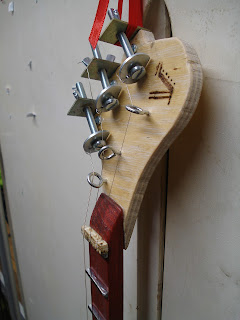Tuning pegs might be one of the trickiest parts of a stringed instrument to get right while still remaining DIY.
There are easy, time tested methods of accurately and reliably tuning strings; such as a set of machine heads like these:
Or zither pins (these are actually amazingly useful, I ordered 100 when I started out and quickly went through them).
Or, if you're lucky, you can try asking any local piano-repair/tuners if they ever throw away old piano tuning pegs. These are basically bigger, stronger versions of the zither pins:
You'll be glad to know that there are very cheap and very easy alternatives that you can get the parts for in most local hardware shops. If you're thinking of making up your own, all you need to understand about pegs is that they control the tension in a string. Most, like those above, do this by wrapping the string around something sturdy and stretching it when the sturdy part is rotated. But you can also stretch the string in other ways using whatever you have lying around and a good dose of creativity.
I'm sure I'm not the first person to have thought up the following alternatives, they just happen to be a few that I've tried out in my few years of making. There are uncountable different methods of tuning out there. Hopefully some of these ideas might inspire you to create your own.
Stretching with Bolts and Washers:
For these tuners the string is tied tightly to a washer that's on the end of a bolt that's nut is close to it's end. When you tighten the nut, the bolt slowly gets shorter which pulls on the string increasing it's tension. It's a tricky method and not the most reliable in maintaining it's tuning, however there are times when tuning doesn't matter as much that this method is quite useful for.
I have a more detailed post on how these were built at this post:
http://vulpestruments.blogspot.co.uk/2010/10/10p-tuning-peg.html
An alternative to using washers is to find bolts that already have a hole at the end in order to secure the wire. Two readily avaliable examples are Eye bolts:
An alternative to using washers is to find bolts that already have a hole at the end in order to secure the wire. Two readily avaliable examples are Eye bolts:
And also the bolts used to secure plug chains to baths/sinks
Note, it's best to tie the string tight when the nut is close to the very end of the bolt, this gives you more space to tighten/increase tension in the string.
Twisting:
You can twist two strings around each other enough that it will seem like one slightly larger string. The more you twist, the more tension.
I've managed to turn a pringle tube into both a resonator and tuning peg in one fell swoop. By having 2 holes in both the lid and the base and looping the string around each hole, you can twist the lid enough to twist the string around itself to increase it's tension. The tension of the string keeps the lid in place and prevents it from becoming untuned.
You can try this with most round containers, but I'd advise placing a nail, or a button, or something firm on the plastic lid to prevent tearing.
Also, you can use bolts like the ones mentioned above to twist a string around itself:
Screws and Connectors
For these ones I stripped the plastic coating off some electrical connectors, screwed them tightly to the end of some long thin screws and tied the string around the connectors bolts. These images might help explain it better:
For these ones I stripped the plastic coating off some electrical connectors, screwed them tightly to the end of some long thin screws and tied the string around the connectors bolts. These images might help explain it better:
It helps if the wood is good quality so that the screws don't slip under tension. Also, different ratings for the connectors are different sizes So the larger the amp rating the better.
Notched Bolts
If you can cut a decent sized notch into a decent sized bolt, you can thread the string through it and increase the tension by twisting the bolt and tightening the nut to keep it secure.
This method is surprisingly effective and keeps in tune well. It can be tricky to get the right pitch you're after in the first place though!
Bolts as more traditional machine heads



















